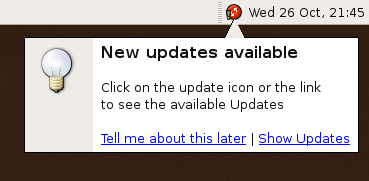Ubuntu 5.10
Thursday 27th October 2005
Categories: Reviews, GNU/Linux, FLOSS
General Use
So, what packages do we end up with? For a start, there's Gnome 2.12, which is presented to you once the installation has finished. Ubuntu is still sticking with the brown theme; however, I am not. The first thing I did was go into the menu and change the theme to Clearlooks. This isn't really a bad point - so long as you have the choice of changing theme, I don't mind.
There are various other packages that you might expect: GAIM, OpenOffice.org 2 (although at this point it was still in Beta), the GIMP, Mozilla Firefox, the list goes on. I still had to download a couple of packages that I wanted, such as gFTP. Some of these packages are kept in a separate repository called Universe - in order to access it, you need to comment out the appropriate lines in /etc/apt/sources.list. Fortunately for those afraid of a terminal, you can do it from within Synaptic as well. It is interesting that I have yet to see the Universe repository even mentioned outside of editing sources.list - had I not known before installation about the repository, I probably would never have found it. I would have at least talked about it in the installation, and perhaps given the user the chance to enable the repository if they saw fit. You might say that would overcomplicate the installation; I say, if that were the case, why not have a normal installation, and an expert installation? Keep the normal installation in its current state, and let the expert installation choose what packages to install, and what repositories to include. Considering the huge range of packages, it really would be a shame if so many people didn't know about them.
There are multiple ways to install packages. The first is through the command line, using apt-get, as you might have expected from a Debian derivative. As usual, along with apt-get, you also get Synaptic, a graphical interface to Apt. Searching for and installing packages really is simple with Synaptic, although some may be overwhelmed by the choice. For those people, there is a simpler program called Add Applications, whereby Ubuntu provides a cut down list of the possible packages that you can install. The final package installer is an update mechanism, which automatically searches for updates, and installs them without any problems.

The automatic updates in Ubuntu 5.10. Click to see the other package installation facilities.
All three graphical interfaces are based on Apt, and as such share that strength. Synaptic is clearly the most powerful, with searching, installation, reinstallation and removal made easy, and just as reliable as the command line. The simpler interface is a good addition for those that don't need the power of Synaptic, while the automatic updates should be useful for anybody - I know I probably apply security updates far less often than I should.
One point to note is who updates the system and install packages. It isn't root - it is the first user on the system. The root password is (apparently) randomly generated, and so your chances of guessing correctly are quite slim. Instead, the first user is dumped in the admin group, allowing him/her to do all sorts of root-type-things. Fortunately, you can set the root password yourself using the command line. Personally, I don't really see the point of this. Since that first user effectively has the root privileges, I wouldn't want to do the usual tasks of browsing the internet or doing work as the first user. Instead, I just create another account with the normal restrictions and privileges. For others, it may be useful since it saves them having to remember two passwords, but I believe it decreases the security of the system, and that nobody should do ordinary tasks with those privileges. I would rather just have been asked for a root password at the start, as per most other distributions.
Another nice addition to Ubuntu is SMEG - an editor for the Gnome menu, something which is sorely missing, or, in Gnome 2.12, not that great. This makes modifying the menu far more practical, with the ability to add, remove and hide entries.
